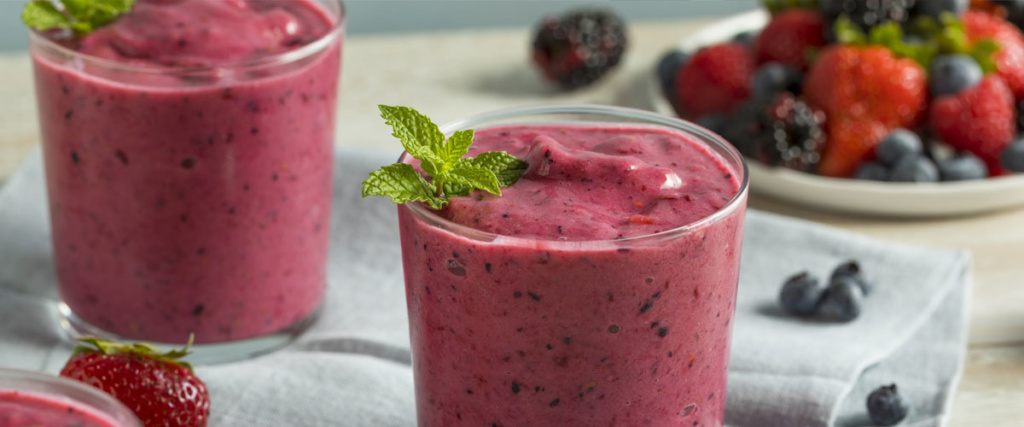When your kids are poking around the kitchen, point them to the produce drawer of the fridge and the blender. With a bit of supervision, they can mix fresh fruits and vegetables into delicious smoothies. Smoothies can be nutrient rich—with a combination of fruits, vegetables, healthy fats, fiber and probiotics. But if you’re not paying attention, a smoothie can become a sugar bomb. Here are some strategies for making delicious and nutritious smoothies.
Smoothie Basics
The best part about making smoothies is that there are seemingly endless combinations of flavors and textures. While there isn’t a right or wrong combination of what to add to a smoothie, it comes down to three basic components: the liquid, the flavor, and the add-ins. As a mom, I love how smoothies are a great way to add a boost of important nutrients; I especially like to focus on adding probiotics to smoothies.
Probiotics (aka “healthy bacteria”) can contribute to gut health and hence overall health. Our intestines are home to hundreds of different bacteria. You can add probiotics in the form of kefir, a drinkable yogurt-like beverage; lassi, a sweet or savory creamy drink; or yogurt. When adding probiotics, especially for children, focus on food or beverage sources, like the ones I’ve listed, instead of supplements. (If you are considering giving your child a pure probiotic supplement, check with your pediatrician first.)
Have fun making smoothies with your family. It’s a great opportunity try different combinations of flavors and find your own personal favorite recipes. In my book Drink Your Way to Gut Health (Houghton Mifflin Harcourt 2015) there is a smoothie recipe named after my husband and one for each of our boys because the recipe was their favorite pick from the book!
The Liquid
The liquid component is an essential part of making the smoothie come together. There are many different options.
- For a creamy texture try milk, kefir or lassi.
- For a lower-calorie option try unsweetened almond milk (only about 40 calories per cup), coconut water (about 45 calories per cup) or water.
- For a tropical taste try coconut milk beverage or coconut water.
The Flavor
Fruits and vegetables add fiber plus vitamins, minerals and powerful plant compounds (phytochemicals). Try these fruit and vegetable combinations.
- Spinach + Pineapple
- Cherry + Strawberry
- Blueberry + Strawberry
- Cucumber + Mint
- Orange + Mango
- Peach + Pineapple
- Banana + Strawberry
Keep in mind, even when produce is fresh and in season, if you love an icy smoothie texture, then freeze the fruit first; you prepare fruit by removing the skin or peel (if necessary) and cutting it into cubes. Note: Vegetables like spinach and cucumbers tend to work best when they are fresh.
The Add-Ins
Enhance your smoothie with fiber, probiotics and healthy fats from things like seeds, nuts and yogurt. When it comes to choosing add-ins, adjust depending on your goals. If you are trying to keep the calories down in the smoothie, add something like chia seeds or powdered peanut butter. If you are looking for a calorie boost, add peanut butter or another nut or seed butter. Always start with a little less than you want because you can always add more.
- Chia seeds add fiber and omega-3 fats (1 tablespoon: 17 calories, 1 gram fiber).
- Peanut butter adds monounsaturated fat and protein (2 tablespoons: 190 calories, 16 grams fat, 8 grams protein).
- Powdered peanut butter includes fewer calories but has peanut flavor plus fiber (2 tablespoons: 45 calories, 2 grams fiber).
- Greek yogurt adds protein (one 6 ounce container: 150 calories, 13 grams protein).
- Flax meal adds healthy fats and fiber (2 tablespoons: 70 calories, 5 grams fat, 3 grams fiber).
The Ratio
A general ratio of ingredients for a single smoothie that works well is: 1 cup liquid, 1 cup fruit and/or vegetables, 1 add-in (vary amount based on what it is), and 4 to 5 or more ice cubes. Note: If you are using frozen fruit you may find you can skip the ice cubes.
The fresh flavors of the ingredients are often enough sweetness, although if you find you need more sweetness add small amounts of honey or agave nectar and then blend again.
Blender Time
When it comes to combining your smoothie, first have everyone wash their hands for at least 20 seconds with warm and soapy water. Then have your children work with you to select their ingredients and add the ingredients to the blender. (Of course, teach them to stay away from the sharp blades!) Next work with them to place and secure the top of the blender and blend away; continue blending until the smoothie is icy. Enjoy right away if you prefer the icy texture or store extras in the refrigerator or in ice pop molds in the freezer for a frozen treat.
Have fun making delicious and nutrient-rich smoothies and cheers to a smoothie summer!





